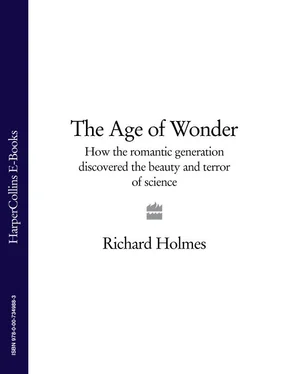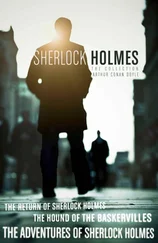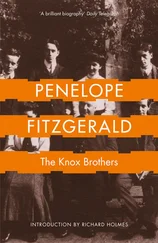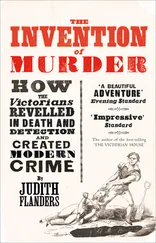In 1781 Banks was knighted for his energetic scientific work as Director of the royal gardens at Kew. Over the next decade he transformed the rambling and disorganised estate along the Thames into a scientific repository and botanical haven that far outstretched anything achieved by Linnaeus. He established more than 50,000 trees and shrubs at Kew, and introduced a vast number of new and exotic species that are now regarded as native: among them magnolias, fuchsias, monkey-puzzle trees, and the evergreen sequoia. 101 He had notable successes with rare and difficult species such as the Venus fly-trap. The poet Coleridge among others refers to him as a reliable source of new exotic and experimental drugs such as Indian hemp, ‘Bang’ and cannabis. 102
Yet the world of the South Pacific was drifting steadily away from Banks. His great companion and fellow voyager, the amiable, easy-going and ever-faithful Solander, was struck down by a heart attack, and died in the guest room at Soho Square in June 1782. Banks was inconsolable, and felt this loss more than any other he had experienced: it seemed to him the loss also of his own youth. He wrote tight-lipped to a mutual friend, John Lloyd: ‘To write about the loss of poor Solander would be to renew both our feelings for little purpose; suffice it to say then that few men, however Exalted their pursuits, were ever more feelingly missed either in the paths of Science or of Friendship.’ 103
A little later he wrote more confidentially to Johann Alströmer, who had once shared their carefree dinners with Sarah Wells, and who was now elected President of the Swedish Academy of Sciences. ‘His loss is irreplaceable. Even if I were to meet such a learned and noble man as he was, my old heart could no longer receive the impression which twenty years ago it took as effortlessly as wax, one which will not dissolve until my heart does…I can never think of it without feeling such acute pain as makes a man shudder.’ 104
There were now fewer and fewer survivors from the original voyage to Paradise; Banks felt like the ‘last of the Otaheites’. Perhaps also it was Solander’s death which fatally delayed any further work on Banks’s great Endeavour travel book. In 1785 he still wrote hopefully, seeing it as a kind of memorial to his friend: ‘Solander’s name will appear next to mine on the title page because everything has been brought together through our common industry. There is hardly a single clause written in it, while he lived, in which he did not have a part…it can be completed in two months if only the engraver can be brought to put the finishing touches to it.’ 105 But nothing appeared.
Banks suffered his first serious and disabling attack of gout in the summer of 1787, when he was still only forty-four. He received a sympathetic letter from the King, but neither realised how grave the affliction would become. By his fifties he was almost literally tied to his presidential chair, as he had feared and prophesied. Incapacitated by agonising swellings in his legs, the once tireless and athletic young explorer had to be pushed about his London house in a wheelchair.
His body may have been chairbound, but his spirit was increasingly airborne. In fact Banks’s personal enthusiasm as the universal scientific patron largely shaped and directed the adventurous character of Romantic science, which now flowered and flourished like one of his most exotic specimens. He revealed himself as a talent-spotter of genius, encouraging expeditions to Australia, Africa, China and South America; supporting projects as diverse as telescope-building, ballooning, merino sheep-farming and weather forecasting; helping to found museums of botany, anthropology, comparative anatomy; and above all maintaining through a huge network of correspondence and personal meetings the idea of science as a truly shared and international endeavour, even in a time of war, and even in relentless (if well-mannered) competition with the French. ♣
He now looked back proudly at his own voyage as something historic and exemplary, to be emulated by the next generation: ‘I may flatter myself that being the first man of scientific education who undertook a voyage of discovery, and that voyage of discovery being the first that turned out satisfactorily in this enlightened age, I was in some measure the first who gave that turn to such voyages.’ 106
The great French naturalist Georges Cuvier agreed, later describing the Endeavour voyage as forming ‘an epoch in the history of science. Natural history contracted an alliance with astronomy and exploration, and began to extend its researches over an ever-widening sphere…Everything seemed to realise the romantic wonders of the Odyssey…Banks displayed his astonishing energy: fatigue did not depress him, nor danger deter him…and not simply by seeing, but by actively observing, he showed his true scientific character…Banks was always in the advance.’ 107
Banks wrote provokingly to a young man hesitating to embark on a perilous scientific expedition to the feverish shores of Java: ‘I have no doubt [your family] wish to force you to adopt Sardinapalus’s advice to his citizens to “Eat, drink & propagate”…Let me hear from you how you feel inclined to prefer Ease and indulgence to Hardship and activity. I was about 23 when I began my Perigrinations; you are somewhat older, but you may be assured that if I had listened to a multitude of voices that were raised up to dissuade me from my Enterprise, I should have now been a Quiet country gentleman.’
Banks’s house in the south-west corner of Soho Square soon became known as the operations centre of scientific research in Britain. It was widely recognised as such throughout Europe-especially in France, Germany and Scandinavia. His correspondence reached round the world, from Paris to New York to Moscow to Sydney. He had the ear of George III (until the King went mad). His library and herbarium were open to all; his daily ten o’clock planning breakfasts at Soho Square were famous; his house parties at his new country estate at Spring Grove in Surrey, purchased especially for the purpose, were often like international conferences.
He received visitors from all over the world, and was the patron of numerous private projects. He advised on the settlement of Australia, was made a Privy Councillor in 1797, and served on the Board of Longitude. After some early disagreements, he became the close friend of the Astronomer Royal, Nevil Maskelyne. Later he was elected President of the Africa Association (which eventually became the Royal Geographical Society), and one of the founding Vice-Presidents of the Royal Institution. He began to exercise a dominant influence over the public development of British science and exploration, encouraging royal patronage, finding funds for research projects and expeditions, and skilfully boosting their national prestige. In effect Banks became Britain’s first Minister for Science.
Yet Joseph Banks never finally published his long-dreamed-of Endeavour Voyage, or any full account of his time in Paradise. Despite the death of his great friend Solander there is no real explanation for this failure, though perhaps it was a deliberate refusal. His journal exists in several manuscript drafts-one copied (and somewhat bowdlerised) by his sister Sophia; and there is a huge series of astonishing engravings (now archived in the Natural History Museum, London). Versions of the journal have been published by scholars, notably by J.C. Beaglehole, in facsimile by the Banks Society, and one recently put online by the University of New South Wales, Australia. But Banks’s Endeavour Voyage may count as one of the great unfinished masterpieces of Romanticism, as mysterious in its own way as Coleridge’s ‘Kubla Khan’, with which it bears some curious similarities, as an account of a sacred place which has been partly lost, and to which there is no return. ♣
Читать дальше












